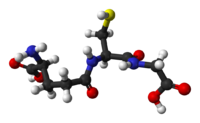
Photo from wikipedia
Cysteine Synthase (CS), the enzyme that synthesizes cysteine, performs non-canonical regulatory roles by binding and modulating functions of disparate proteins. Beyond its role in catalysis and regulation in the cysteine… Click to show full abstract
Cysteine Synthase (CS), the enzyme that synthesizes cysteine, performs non-canonical regulatory roles by binding and modulating functions of disparate proteins. Beyond its role in catalysis and regulation in the cysteine biosynthesis pathway, it exerts its moonlighting effect by binding to few other proteins which possess a C-terminal "CS-binding motif", ending with a terminal ILE. Therefore, we hypothesized that CS might regulate many other disparate proteins with the "CS-binding motif". In this study, we developed an iterative sequence matching method for mapping moonlighting biochemistry of CS and validated our prediction by analytical and structural approaches. Using a minimal protein-peptide interaction system, we show that five previously unknown CS-binder proteins that participate in diverse metabolic processes interact with CS in a species-specific manner. Furthermore, results show that signatures of protein-protein interactions, including thermodynamic, competitive-inhibition, and structural features, highly match the known CS-Binder, serine acetyltransferase (SAT). Together, the results presented in this study allow us to map the extreme multifunctional space (EMS) of CS and reveal the biochemistry of moonlighting space, a subset of EMS. We believe that the integrated computational and experimental workflow developed here could be further modified and extended to study protein-specific moonlighting properties of multifunctional proteins.
Journal Title: Journal of molecular biology
Year Published: 2021
Link to full text (if available)
Share on Social Media: Sign Up to like & get
recommendations!